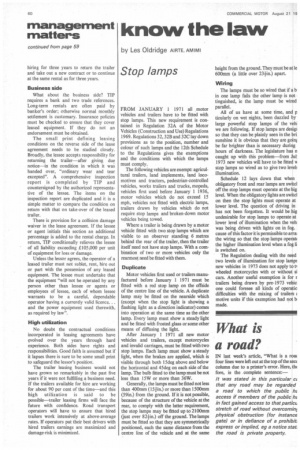know the law
Page 62

If you've noticed an error in this article please click here to report it so we can fix it.
by Les Oldridge AIRTE, AMIMI
Stop lamps
FROM JANUARY 1 1971 all ,motor vehicles and trailers have to be fitted with stop lamps. This new requirement is contained in Regulation 32A of the Motor Vehicles (Construction and Use) Regulations 1969. Regulations 32, 32B and 32C lay down provisions as to the position, number and colour of such lamps and the 12th Schedule to the Regulations gives the exemptions and the conditions with which the lamps must comply.
The following vehicles are exempt: agricultural trailers, land implements, land locomotives and tractors, pedestrian-controlled vehicles, works trailers and trucks, mopeds, vehicles first used before January 1 1936, motor vehicles which do not exceed 15 mph, vehicles not fitted with electric lamps, trailers drawn by vehicles which do not require stop lamps and broken-down motor vehicles being towed.
Where a trailer is being drawn by a motor vehicle fitted with two stop lamps which are visible to an observer standing 6 metres behind the rear of the trailer, then the trailer itself need not have stop lamps. With a combination of two or more vehicles only the rearmost need be fitted with them.
Duplicate Motor vehicles first used or trailers manufactured before January 1 1971 must be fitted with a red stop lamp on the offside of the centre line of the vehicle. A duplicate lamp may be fitted on the nearside which (except when the stop light is showing a flashing light as a direction indicator) comes into operation at the same time as the other lamp. Every lamp must show a steady light and be fitted with frosted glass or some other means of diffusing the light.
After January 1 1971 all new motor vehicles and trailers, except motorcycles and invalid carriages, must be fitted with two stop lamps. Each lamp must show a steady light, when the brakes are applied, which is visible through both 15deg above and below the horizontal and 45deg on each side of the lamp. The bulb fitted to the lamp must be not less than 15W or more than 36W.
Generally, the lamps must be fitted not less than 400mm (15fin.) or more than 1500mm (59in.) from the ground. If it is not possible, because of the structure of the vehicle at the rear, to comply with the latter requirement, the stop lamps may be fitted up to 2100mm (just over 82-1-in.) off the ground. The lamps must be fitted so that they are symmetrically positioned, each the same distance from the centre line of the vehicle and at the same height from the ground. They must be at le 600mm (a little over 23fin.) apart.
Wiring
The lamps must be so wired that if a b in one lamp fails the other lamp is not tinguished, ie the lamp must be wired parallel.
All of us have at some time, and p ticularly on wet nights, been dazzled by large powerful stop lamps of the vehi we are following. If stop lamps are desigi so that they can be plainly seen in the bri sunshine it is obvious that they are going be far brighter than is necessary during hours of darkness. The legislature has n caught up with this problem—from Jul; 1973 new vehicles will have to be fitted n stop lamps so wired as to give two level; illumination.
Schedule 12 lays down that when obligatory front and rear lamps are swiltcl off the stop lamps must operate at the ftig level. When the obligatory lights are switcl on then the stop lights must operate at lower level. The question of driving in has not been forgotten. It would be hig undesirable for stop lamps to operate at lower level of illumination when the velt was being driven with lights on in fog. cause of this factor it is permissible to arra' the wiring so that the stop lamps operatt the higher illumination level when a fog li is switched on.
The Regulation dealing with the need two levels of illumination for stop lamps new vehicles in 1973 does not apply to ti wheeled motorcycles with or without si cars. Another useful exemption is for r trailers being drawn by pre-1973 vehie one could foresee all kinds of operatic difficulties with the mixing of trailers s motive units if this exemption had not b made.














































































































